By Jeffrey A. Rendall, Images Courtesy of TaylorMade Golf
CARLSBAD, CA – One of the most interesting aspects of covering golf products in the past decade is seeing the growth of specialization in the manufacturing industry. It used to be that companies like TaylorMade Golf were known for making high-performance metal woods and irons – but you’d leave the rest of your needs to someone else.
That’s no longer the case, as TaylorMade now produces top quality ‘short game’ products as well as golf balls. We see many professionals putting them into use every week on TV, but you’d be remiss to pass them over in your local shop next time you’re shopping.
For this season, we tried the company’s latest offerings in the putter, wedge and golf ball categories, and were thoroughly impressed with them all. For purposes of this article, we’ll do a little ‘specialization’ of our own and separate the products into three sections.
Ghost Manta Putter
Two years ago, we first looked into the new white ‘Ghost’ franchise of putters and marveled at the odd shapes and unique alignment features – and also loved the way the ball rolled into the hole with greater frequency.
Nothing’s changed in that respect with the latest putter, Ghost Manta, and we’re happy to say that it’s one of the best we’ve ever tried. If you can get past the still-somewhat funky looks (traditionalists will recoil, but writing down lower scores helps cure the initial revulsion).
According to Michael Fox, TaylorMade’s Global Product Category Manager, Putters and Wedges, the new ‘Ghost’ isn’t scaring anyone away from a product that works.
“When we decided to make the Ghost Manta, it was actually a completely different product. It was multi-material, wire framing – just basically, very crazy looking. But, we looked at the marketplace and what golfers were asking for: they said, give me all the performance of those crazy looking putters -- the Spiders, Sabertooths, Gnomes, Stingrays…. There’s a million of ‘em – crazy-shaped putters out there that just boast high performance.”
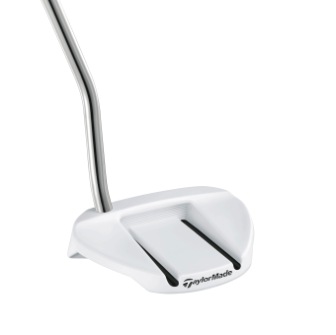 |
So TaylorMade decided to take all the performance characteristics of the crazy-shaped putters and condense them into something with a much cleaner and simpler shape. Hence, the Manta was born.
“We’re finding that many of the players who used to play the ‘crazy’ putters are moving into the Manta because it looks better. And the players who always liked the mallet-shaped putters are also going Manta because it performs way better,” Fox said.
By ‘performance,’ we’re talking about stability and speed control. Stability is achieved in the Manta through a hundred grams of tungsten that you can see on the heel and toe of the putter – positioned right towards the front. This increases the putter’s MOI (moment of inertia), which helps prevent twisting.
With putts of all lengths, that stability is tremendously important.
The face weight distribution also improves speed control. “This is huge for guys on Tour,” Fox added, “because if they’re a couple inches short or long, God knows where those balls can go.”
The pin positions on Tour aren’t forgiving, and missing a putt by a little can mean putting your next one from a lot farther away. As an example, Fox says Justin Rose switched to the Manta mid-tournament in the Masters because he felt his speed control was a little off. The switch allowed him to finish in a tie for 10th.
Being just millimeters off with a putter can mean you’re short – and players are amazed when they’re tested on a performance monitor how much a little can make a difference.
Finally, the Manta is different because of its white color. Not a departure from previous Ghost models, but still meant to help you line things up correctly.
“We started with the white because we found through testing golfers all throughout the country (in TaylorMade fitting centers) just how misaligned people really are. We found that 65 percent of the people that came into these fitting centers – which is tens and tens of thousands – 65 percent of people aren’t aimed at the hole from 12 feet,” Fox explained.
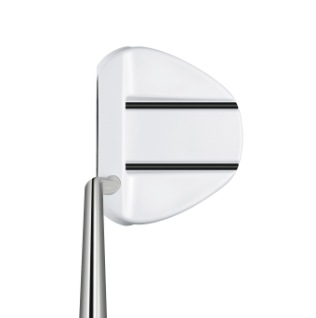 |
“And this is regardless of handicap, it’s regardless of alignment lines, it’s regardless of different putters. 65 percent of golfers can’t even aim the club at the hole. So, we said we need to look at alignment differently. Let’s make a putter that’s easier to see, easier to see the leading edge… and get them aimed at the hole,” he added.
The result was a white putter with greater contrast between the green grass and the white crown, so you can see the leading edge better. The contrast allows you to determine if you’re square to the hole.
And if you are, you’ll make more putts. It really works, folks.
ATV (All Terrain Versatility) Wedge
Come on, a wedge from TaylorMade that works better?
Face it, most wedges still look similar to what they were decades ago. Sure, there are different lofts and bounces, but how much can technology really move the needle?
A lot, it turns out. Michael Fox explains. “The wedge category really hasn’t evolved like a lot of the other club categories. It’s stayed in much more of the conventional wisdom – it’s almost like a social dimension in what people are used to seeing. ‘Hey, this is what a wedge looks like, and that’s the way it’s been for 80 years.’”
“People always thought that those shots are more about feel and look… and that’s true, but people haven’t pushed the performance of what a wedge can do, really for an incredibly long time. It’s all been about perfect fitting for one shot. And what happened was, it just became more and more limiting. Wedges were able to do less and less and less,” Fox lamented.
As a result, TaylorMade set out to make a wedge that could do it all in terms of playability and versatility, and actually making shots. Fox said golfers don’t really understand the different bounces and grinds on wedges in the first place, so it wasn’t helpful to have so many different kinds available in the pro shop.
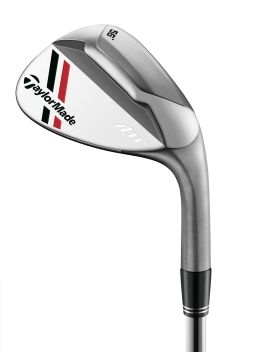 |
The retailers also wanted to bring things down to a sane level. They simply didn’t want to carry 150 different types of wedges that no one seemed to get.
Finally, TaylorMade’s Tour staff said they wanted their wedges to do more – something they could hit out of bunkers as well as use from the fairway. They wanted wedges that would perform in all conditions as well – so they wouldn’t have to change them from course to course.
“In reality, you need the wedge to be more versatile than all different kinds of golf clubs and it was being designed like an iron, really for one shot – which for the most part was either a chip or a full shot out of the fairway,” Fox said.
“So we designed the ATV Wedge to work on every shot for every golfer, for every swing type, on every course condition. On every swing,” he said proudly.
“It’s just an easier wedge to hit to be perfectly honest.”
The wedge appears to have a very wide sole, which took some getting used to, but in general, it is very easy to hit (though I had some trouble with very firm conditions – which is most likely a subjective issue, not attributable to the club).
“There’s still bounce on this wedge, but you can’t say hey, this is a 12-degree bounce wedge because it has six different effective bounces, depending on what kind of shot you’re trying to hit. It’s not about having one bounce. It’s about having the right shape and the right bounce for the shot you’re trying to hit – because you need different bounces for all different types of shots. But just having one couldn’t be more limiting,” Fox said.
If you’re hitting a chip shot, the leading edge dips lower, and it has effective low bounce. If you’re hitting a bunker shot and you open it up, you’ve got that big sole and it’s easier to hit it out of the bunker.
Again, the looks of the ATV might scare you a bit at first. The wide sole almost makes it look like the club has way too much bounce. No problem, says Fox.
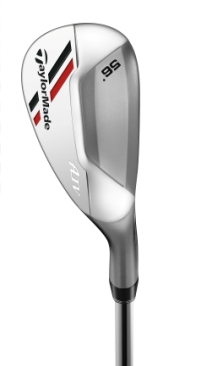 |
“When you hit a shot, you’re really only hitting the ground with the two rails on the underside of the club. It’s a low surface area, so it’s not going to bounce on you. But also with chip shots or flop shots, the concave wedges (like the ATV) feel a lot lower than a standard wedge would be able to. You’re really getting the best of both worlds. That shallow roughed-in center is really the secret to how we’re able to do so many different things with the product.”
“It’s one of those things where we need to do everything we can to just get people to try it. Try it, and it’s going to perform different than the wedge you typically play,” Fox concluded.
There’s little doubt of that. I’ve had some great up-and-downs with this wedge, but I’m also still trying to get used to it. TaylorMade deserves credit for trying something new here – and this is probably what the future will look like in terms of wedge technology.
The New Penta TP5 golf ball
Yet another area where TaylorMade is making breakthroughs is with golf balls. Competition in the industry is intense in this realm, and the company has never been known to shy away from a challenge.
It’s also perhaps the hardest product area to achieve differentiation. Take the logos off, and the average golf consumer wouldn’t know one ball from the next.
Paul English is the Director of TaylorMade’s Golf Ball Division, and he thinks the Penta TP5 ball will blaze some trails of its own.
“When we set out to make a better golf ball than the Penta TP (the previous model), our tour pros were initially skeptical since Penta had performed so well for them. The Penta TP was the first 5-layer Tour ball in golf and a tough one to top.”
He continues, “The one area we sought to improve was creating a more penetrating trajectory to allow Tour players to better control their ball flights through the bag. The Penta TP5’s core and inner mantle layer have a 28% lower compression, allowing for less driver spin and more controlled flight for all shots in the bag.”
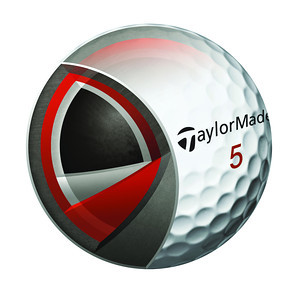 |
“The Penta TP5 still features 5 layer technology – each layer works with the others to provide optimal performance for every shot in the bag,” English said.
Terrific, we all want that. But for those of us below the Tour level, what will the ball do?
Again, English expounds. “Better players like the soft feel of the Penta TP5, but they will fall in love with the penetrating, controlled trajectory on all their full swing shots. This results in better performance in the wind and helps players to reach those tough back pin placements without the ball ballooning on them.”
“Meanwhile, the Penta TP5 also features ‘Progressive Velocity,’ which means the compression of each layer of the ball gets firmer as you move from the Core to the outer mantle. This results in achieving maximum velocity no matter what a player’s swing speed may be. So, whether you’re competing on Tour or picking up the game for the first time, the Penta TP5 gives golfers the best chance to score.”
It’s safe to say that most of us don’t cut the golf balls open to see the layers, and we have to take the manufacturers at their word that each succeeding layer performs a function. But how does all of this translate to the short game?
“It really depends on player preferences. Most Tour and better players prefer maximum greenside spin and control (high spin rates on less than full swing shots). This is what TaylorMade offers in its cast urethane Penta golf balls…and we do this while providing the maximum distance off the tee,” English lectured.
“However, some golfers prefer to play a consistent ‘bump and run’ type of shot or a higher launch chip shot with less spin and some release. For these golfers, our iothane covered balls like Rocketballz are a good choice.”
Choice is a good thing, and most manufacturers offer that type of variety to match your golf game.
It all boils down to personal preference, and all we can recommend when it comes to golf balls is to try a lot of different kinds and see which one you feel most comfortable with. Ball fitting is also becoming popular, and asking your local pro which ball will work best for you is always a wise option.
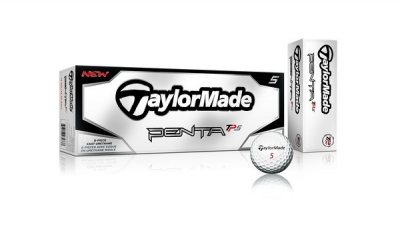 |
We enjoyed the Penta TP5 ball, and found that it certainly flies a long way – you’ll be more than satisfied in terms of distance. Trajectory was similar to other balls in the high-end category and it had a real nice, soft feel.
It should be noted that we don’t test any product scientifically, so it’s basically a thumbs-up vs. thumbs down proposition. One thing we noted was the ball curves a bit more than some other models, so keep that in mind if you have a tendency to hit it off-line.
Summing it up
TaylorMade continues to impress with its latest clubs and golf balls, and the company deserves high marks for innovation and a willingness to introduce products that are a tad non-traditional.
Try them for yourself – and you likely won’t be disappointed.
Details:
TaylorMade’s Penta TP5 ball, Ghost Manta Putter and ATV Wedge
Available at your higher-end golf retailers and club pro shops.
Check out more information about TaylorMade products at: www.taylormadegolf.com.
TaylorMade became famous for pioneering metal woods, but the company now produces everything from metal woods to wedges to putters. And since joining with Adidas (and Ashworth), don’t forget footwear and clothing. Check out the website for more information.
| Related Links | Comments on this article? | |
|
Maryland National Golf Club Hollow Creek Golf Club Rocky Gap Resort PB Dye Golf Club in Ijamsville Whiskey Creek Golf Club |
E-mail Jeff Rendall, Editor: jrendall@golftheunitedstates.com |












